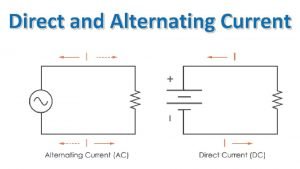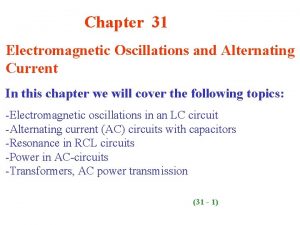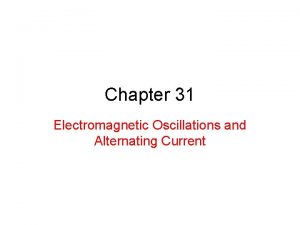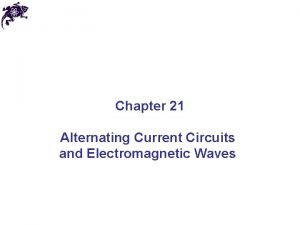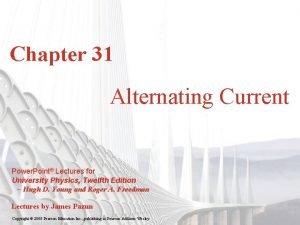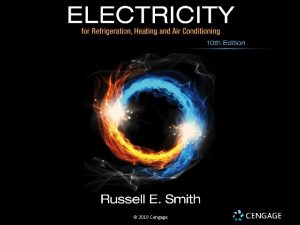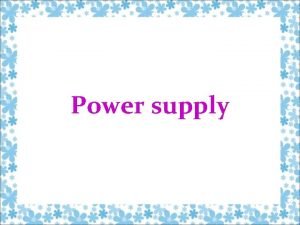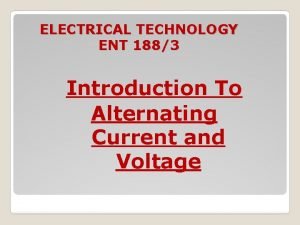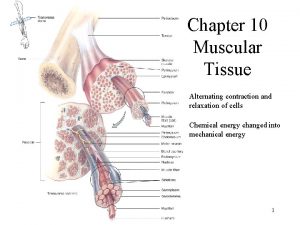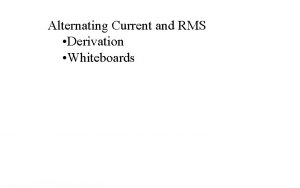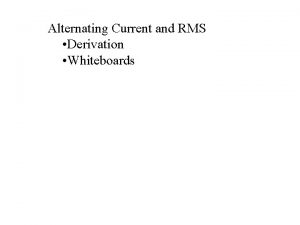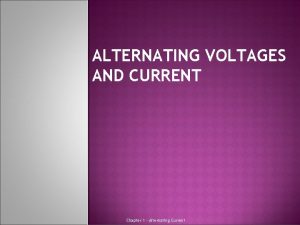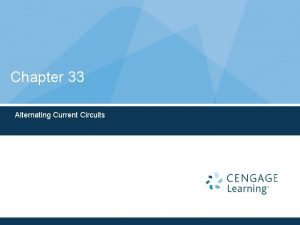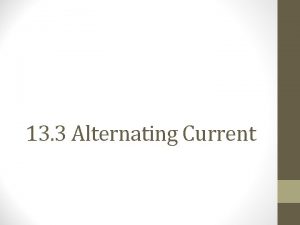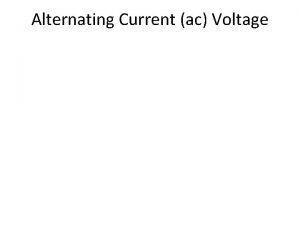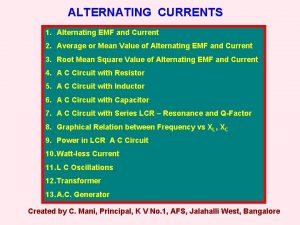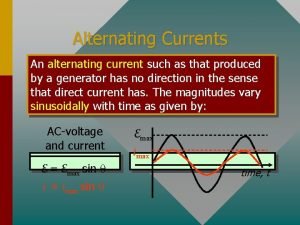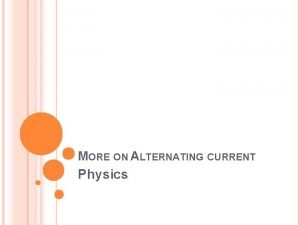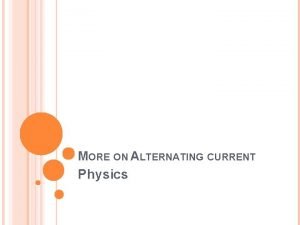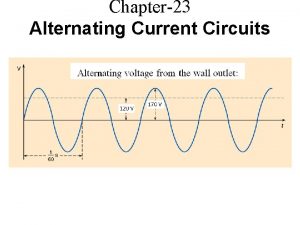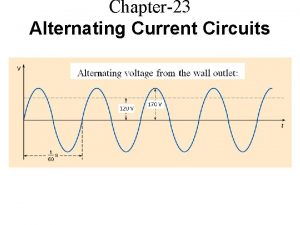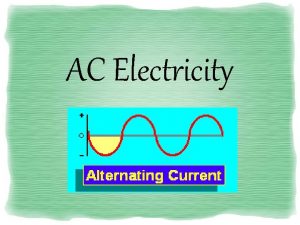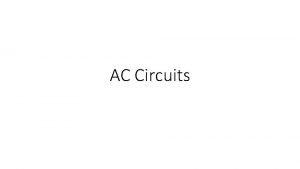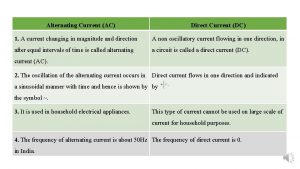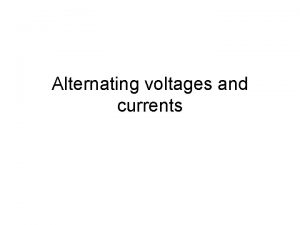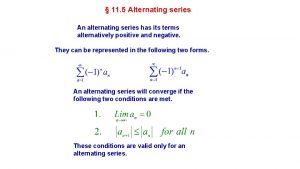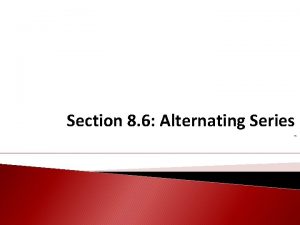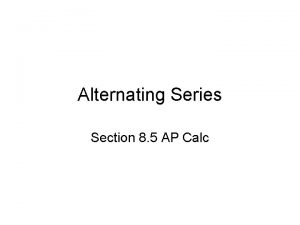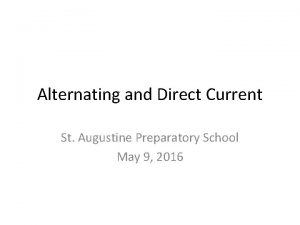Direct and Alternating Current Direct and Alternating Current























- Slides: 23

Direct and Alternating Current

Direct and Alternating Current Direct Current (DC) • Current that flows in only one direction through a wire • Ex: a battery

Alternating Current (AC) • Reverses the direction of the current flow in regular patterns • Ex: a plugging a toaster into an outlet

ELECTRIC CIRCUITS 6. 3

ELECTRIC CIRCUITS • Complete path through which charge can flow. • Switches can be opened to allow electricity to flow or closed.

Copy these electric circuit symbols into your notebook. Use these symbols when drawing your circuits.

TYPES OF CIRCUITS Series Circuit – charge has ONLY ONE way to flow (direct current) • If one element stops working they all stop • EX: Flashlight, car, holiday lights


Parallel Circuit – charge can flow through TWO or MORE pathways (alternating current). • If one element stops functioning the rest will still operate • EX: House

Complex Circuits • A circuit composed of both series and parallel circuits

ELECTRICAL SAFETY Electrical energy enters your home at the circuit breaker or fuse box and branches out to appliances, wall sockets, and lights.

ELECTRICAL SAFETY • Fuse – prevents current overload in a circuit by melting • Circuit Breaker –switch that opens when the current in a circuit is too high • Grounding – transfer of excess charge through a conductor to Earth

Electrical Power • rate at which electrical energy is converted to another form of energy • SI unit for electrical power is Watt (w) P=I×V P - power (W) I - current (A) V- potential difference (V)

A calculator has a 0. 01 A current flowing through it. It operates with a potential difference of 9 V. How much power does it use? WORK: GIVEN: I = 0. 01 A V=9 V P=? P I V P=I·V P = (0. 01 A) (9 V) P = 0. 09 W

PRACTICE Problems 16. A toaster oven is plugged into an outlet where the voltage difference is 120 V. How much power does the toaster oven use if the current in the oven is 10 A? GIVEN: WORK: I = 10 A V = 120 V P=? P=I·V P = (10 A) (120 V) P = 1, 200 W P I V

PRACTICE Problems 17. A video-disc player that is not playing still uses 6. 0 W of power. What is the current into the video-disc player if it is plugged into a standard 120 -V outlet? GIVEN: WORK: I=? V = 120 V P = 6. 0 W I = P/V I = 6. 0 W / 120 V I = 0. 05 A P I V

PRACTICE Problems 17. A video-disc player that is not playing still uses 6. 0 W of power. What is the current into the video-disc player if it is plugged into a standard 120 -V outlet? 0. 05 A

PRACTICE Problems 18. A flashlight bulb uses 2. 4 W of power when the current in the bulb is 0. 8 A. What is the voltage difference supplied by the batteries? 3 V

Electrical Energy • energy use of an appliance depends on power required and time used E=P×t E - energy (k. Wh) P - power (k. W) t - time (h)

A refrigerator is a major user of electrical power. If it uses 700 W and runs 10 hours each day, how much energy (in k. Wh) is used in one day? GIVEN: P = 700 W = 0. 7 k. W t = 10 h E=? E P t WORK: E=P·t E = (0. 7 k. W) (10 h) E = 7 k. Wh

PRACTICE Problems 21. A TV with a power rating of 200 W uses 0. 8 k. Wh of electrical energy in one day. For how many hours was the TV on during this day? 4 hours

PRACTICE Problems 22. A hair dryer has a power of 1, 200 W. How much electrical energy does the hair dryer use in 3 minutes? 0. 06 k. Wh

Electric Circuits Review 1. What is a series circuit? 2. What is an example of a series circuit? 3. What is a parallel circuit? 4. What is an example of a parallel circuit? 5. What is the Scientific Unit for electrical power? 6. What is the definition of electrical power? 7. What is a circuit breaker? 8. What does a fuse prevent? 9. What is grounding? 10. What is the Scientific Unit for electric current?
 Alternating current practice problems
Alternating current practice problems Electromagnetic oscillations and alternating current
Electromagnetic oscillations and alternating current Electromagnetic oscillations and alternating current
Electromagnetic oscillations and alternating current Alternating current circuits and electromagnetic waves
Alternating current circuits and electromagnetic waves Ac dc graph
Ac dc graph Alternating current ppt
Alternating current ppt Chapter 7 alternating current
Chapter 7 alternating current A psu converts alternating current to what
A psu converts alternating current to what Alternating current introduction
Alternating current introduction Direct current transformer
Direct current transformer Line currents
Line currents Power formula three phase
Power formula three phase Drift current and diffusion current
Drift current and diffusion current Ac systems lesson 4
Ac systems lesson 4 Drift current and diffusion current in semiconductor
Drift current and diffusion current in semiconductor Drift current and diffusion current
Drift current and diffusion current Balanced wye-wye connection
Balanced wye-wye connection Slideplayer
Slideplayer Diffusion current density
Diffusion current density The constant-current area of a fet lies between
The constant-current area of a fet lies between All of the heat produced by sma weld stays in the weld.
All of the heat produced by sma weld stays in the weld. Hazard based safety engineering
Hazard based safety engineering Kcl mesh analysis
Kcl mesh analysis Alternating contraction and relaxation
Alternating contraction and relaxation
